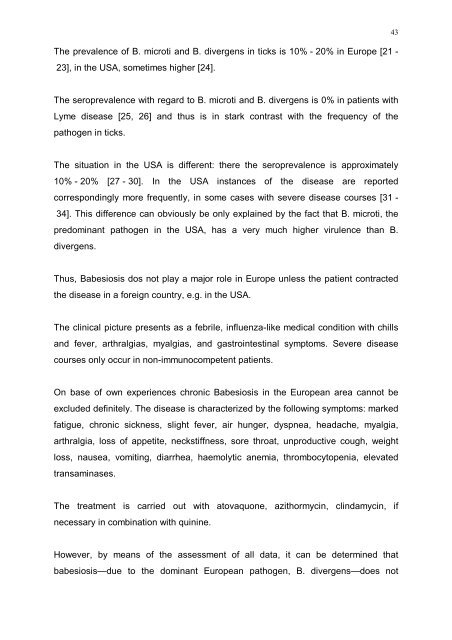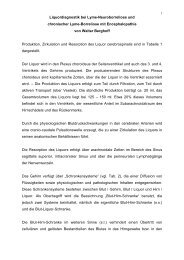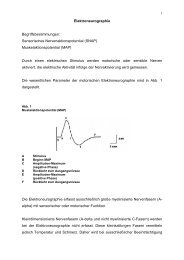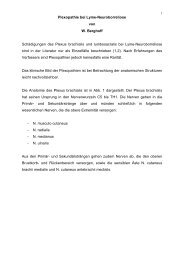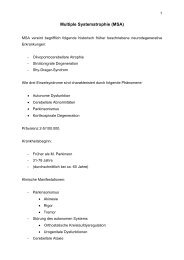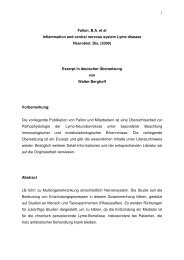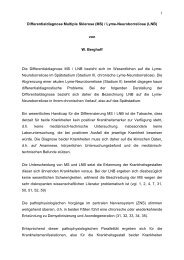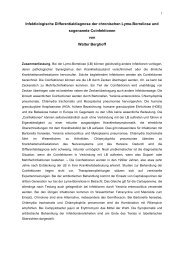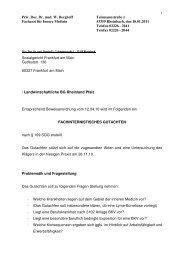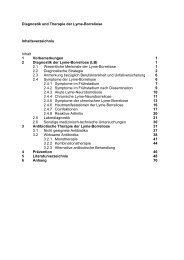Infectiologic differential diagnosis of chronic Lyme disease and so ...
Infectiologic differential diagnosis of chronic Lyme disease and so ...
Infectiologic differential diagnosis of chronic Lyme disease and so ...
You also want an ePaper? Increase the reach of your titles
YUMPU automatically turns print PDFs into web optimized ePapers that Google loves.
The prevalence <strong>of</strong> B. microti <strong>and</strong> B. divergens in ticks is 10% - 20% in Europe [21 -<br />
23], in the USA, <strong>so</strong>metimes higher [24].<br />
The seroprevalence with regard to B. microti <strong>and</strong> B. divergens is 0% in patients with<br />
<strong>Lyme</strong> <strong>disease</strong> [25, 26] <strong>and</strong> thus is in stark contrast with the frequency <strong>of</strong> the<br />
pathogen in ticks.<br />
The situation in the USA is different: there the seroprevalence is approximately<br />
10% - 20% [27 - 30]. In the USA instances <strong>of</strong> the <strong>disease</strong> are reported<br />
correspondingly more frequently, in <strong>so</strong>me cases with severe <strong>disease</strong> courses [31 -<br />
34]. This difference can obviously be only explained by the fact that B. microti, the<br />
predominant pathogen in the USA, has a very much higher virulence than B.<br />
divergens.<br />
Thus, Babesiosis dos not play a major role in Europe unless the patient contracted<br />
the <strong>disease</strong> in a foreign country, e.g. in the USA.<br />
The clinical picture presents as a febrile, influenza-like medical condition with chills<br />
<strong>and</strong> fever, arthralgias, myalgias, <strong>and</strong> gastrointestinal symptoms. Severe <strong>disease</strong><br />
courses only occur in non-immunocompetent patients.<br />
On base <strong>of</strong> own experiences <strong>chronic</strong> Babesiosis in the European area cannot be<br />
excluded definitely. The <strong>disease</strong> is characterized by the following symptoms: marked<br />
fatigue, <strong>chronic</strong> sickness, slight fever, air hunger, dyspnea, headache, myalgia,<br />
arthralgia, loss <strong>of</strong> appetite, neckstiffness, <strong>so</strong>re throat, unproductive cough, weight<br />
loss, nausea, vomiting, diarrhea, haemolytic anemia, thrombocytopenia, elevated<br />
transaminases.<br />
The treatment is carried out with atovaquone, azithormycin, clindamycin, if<br />
necessary in combination with quinine.<br />
However, by means <strong>of</strong> the assessment <strong>of</strong> all data, it can be determined that<br />
babesiosis—due to the dominant European pathogen, B. divergens—does not<br />
43


